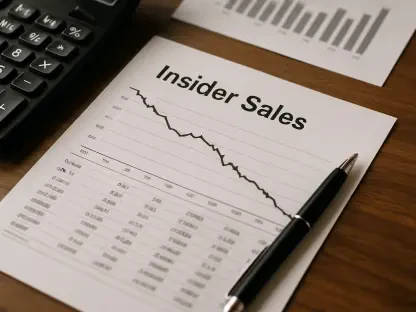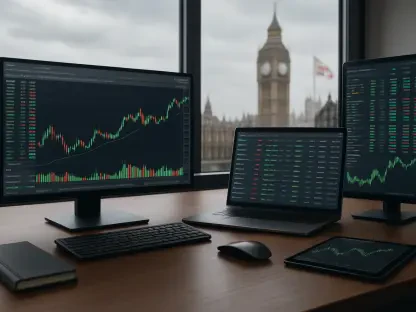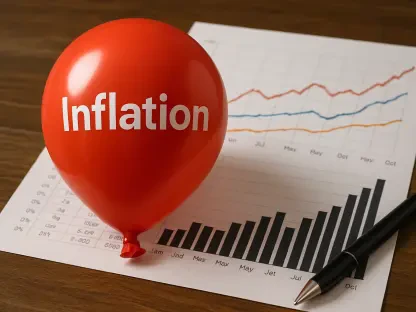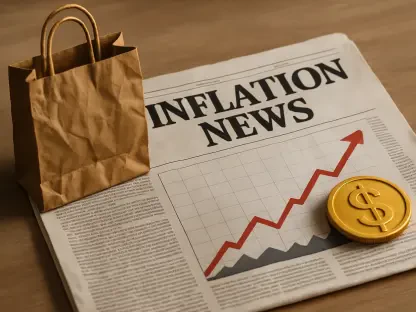The commodity market in the United States is currently riding a wave of unprecedented momentum, with gold, oil, and base metals such as copper and silver experiencing dramatic price surges that have left investors and analysts scrambling to understand the underlying forces driving this trend. This rally, unfolding in the latter part of this year, is not merely a blip on the financial radar but a complex phenomenon fueled by a potent mix of political optimism and economic indicators. Hopes for a resolution to a prolonged government shutdown have calmed market nerves, redirecting attention from uncertainty to potential growth. Simultaneously, disappointing economic data, marked by significant job cuts and dwindling consumer confidence, has intensified speculation about Federal Reserve interest rate cuts. This combination is creating a fertile environment for commodities, propelling prices to levels that demand closer scrutiny.
Beyond the immediate numbers, this surge signals deeper currents shaping the global economic landscape. Gold has soared past $4,000 per ounce, with peaks even reaching $4,400, cementing its status as a go-to safe-haven asset amid persistent global unease. Oil, trading between $65 and $85 per barrel for Brent crude, is buoyed by demand tied to cutting-edge technologies like AI data centers, while base metals are gaining ground due to their pivotal role in the energy transition. These price movements raise critical questions about sustainability and the broader implications for economies worldwide. Are these spikes a fleeting response to domestic policy shifts, or do they hint at enduring trends? The interplay of a softening US dollar, expected monetary easing, and shifting demand dynamics offers a glimpse into the forces at play, setting the stage for a detailed exploration of this remarkable market moment.
Unpacking the Catalysts of the Commodity Boom
Political Optimism and Economic Softness
The prospect of resolving the ongoing US government shutdown has emerged as a pivotal factor in stabilizing financial markets, easing the pervasive anxiety that often drives investors toward safe-haven assets. This shift in sentiment has allowed a renewed focus on economic fundamentals rather than political gridlock, creating a more favorable backdrop for risk-taking in commodity investments. Despite this, gold continues to hold strong appeal due to lingering international concerns that transcend domestic politics. At the same time, recent economic data paints a troubling picture, with job cuts reaching levels not seen in decades and consumer confidence taking a noticeable hit. These indicators have amplified expectations of Federal Reserve intervention through interest rate reductions, a move that historically boosts commodity prices by lowering the cost of holding non-yielding assets and stimulating broader economic activity. This dual dynamic of political hope and economic concern forms the bedrock of the current rally, influencing market behavior across multiple sectors.
Moreover, the impact of these economic signals cannot be understated, as they shape investor perceptions and policy anticipations in profound ways. A weaker economic outlook often pressures central banks to adopt accommodative monetary policies, which in turn devalue the US dollar and make commodities more attractive to global buyers. This effect is particularly pronounced in markets sensitive to currency fluctuations, where a depreciating dollar translates into higher demand for oil and metals priced in that currency. While the resolution of political standoffs provides a short-term lift, the persistent softness in key economic metrics suggests that the Federal Reserve’s next moves will be closely watched. Any hint of delay or deviation from expected rate cuts could introduce volatility, potentially undermining the rally’s momentum and forcing investors to reassess their positions in commodities.
Impact of Monetary Policy Expectations
Anticipation of Federal Reserve rate cuts stands as a cornerstone of the current commodity price surge, fundamentally altering the financial landscape for assets like gold that do not yield interest. Lower rates diminish the opportunity cost of holding such assets, making them more appealing compared to interest-bearing alternatives like bonds. Additionally, a policy shift toward easing typically weakens the US dollar, which in turn makes dollar-denominated commodities more affordable for international markets, driving up demand for everything from crude oil to industrial metals. This monetary backdrop is not just a theoretical driver but a tangible force, evident in the robust trading volumes and price upticks observed across commodity exchanges. The expectation of a more lenient monetary stance is thus fueling a broad-based rally, with implications for both short-term speculation and long-term investment strategies.
However, the reliance on expected rate cuts introduces a layer of fragility to this upward trend, as central bank decisions are not guaranteed and can pivot based on incoming data or global events. Should the Federal Reserve adopt a more cautious or hawkish stance—perhaps in response to unexpected inflationary pressures or geopolitical shocks—the current optimism could quickly dissipate. A stronger dollar resulting from tighter policy would likely dampen demand for commodities by making them costlier for foreign buyers, reversing some of the gains seen in oil and base metals. Furthermore, the interplay between domestic monetary policy and international economic conditions adds complexity, as other central banks may not align with the Fed’s direction, creating discrepancies in currency values and commodity pricing. This uncertainty underscores the need for vigilance among market participants navigating this rally.
Sector-Specific Dynamics in the Rally
Gold’s Enduring Safe-Haven Status
Gold’s meteoric rise above $4,000 per ounce, with temporary peaks at $4,400, highlights its unshakable position as a refuge for investors during times of uncertainty, even as domestic political tensions ease. This price surge is underpinned by a combination of factors, including persistent geopolitical risks and central banks’ ongoing efforts to diversify reserves away from traditional currencies. Projections suggest gold could climb to $5,000 by mid-2026, reflecting sustained demand driven by both institutional and individual investors seeking protection against inflation and global instability. Unlike other commodities, gold’s value is less tied to industrial use and more to its perception as a store of wealth, a characteristic that becomes particularly pronounced when economic or political storms loom on the horizon. This rally in gold prices is a clear indicator of underlying anxieties that continue to shape market sentiment.
Additionally, the role of central banks in bolstering gold’s price cannot be overlooked, as many are actively increasing their holdings to hedge against currency depreciation and fiscal uncertainties. This trend, coupled with retail investor interest spurred by accessible investment vehicles like exchange-traded funds, creates a robust demand base that shows little sign of abating. The expectation of lower interest rates further enhances gold’s allure, as the cost of holding this non-yielding asset decreases, making it a more competitive option in diversified portfolios. However, potential risks remain, such as a sudden strengthening of the US dollar or a resolution of major geopolitical conflicts, which could reduce safe-haven demand. Despite these possibilities, gold’s trajectory in the current market environment appears strongly bullish, reflecting a deep-seated need for stability among global investors.
Oil’s Balancing Act Between Demand and Oversupply
Oil prices, currently oscillating between $65 and $85 per barrel for Brent crude, are experiencing a lift from forward-looking demand tied to technological advancements such as AI-driven data centers and widespread electrification initiatives. These emerging sectors promise to sustain long-term consumption, particularly as global economies pivot toward digital and energy-efficient infrastructures. However, this optimism is tempered by structural challenges that paint a less certain picture for oil’s future. Analysts point to a potential oversupply in the market, driven by increased production capacities and alternative energy sources gaining traction, which could exert downward pressure on prices. This duality of robust demand drivers and looming supply gluts creates a complex environment for oil, distinguishing it from the more uniformly bullish outlook for other commodities in this rally.
Looking ahead, the bearish pressures on oil are becoming more apparent, with forecasts suggesting a possible decline to a range of $50 to $58 per barrel by 2026 if oversupply concerns materialize alongside slowing global demand growth. This potential downturn contrasts sharply with the current price stability and reflects broader shifts in the energy landscape, where renewable sources are increasingly displacing traditional fossil fuels. Geopolitical developments also play a critical role, as tensions in oil-producing regions can introduce sudden price spikes, while diplomatic resolutions might ease supply fears. For now, oil remains a commodity caught between innovation-driven demand and the realities of a transitioning energy market, requiring investors to carefully weigh short-term gains against longer-term structural challenges that could reshape its valuation.
Base Metals Fueling the Green Energy Shift
Base metals, particularly copper and silver, are carving out a significant space in the current commodity rally, propelled by their indispensable role in the global transition to sustainable energy systems. Copper, often dubbed the metal of electrification, is seeing heightened demand due to its use in electric vehicles, renewable energy grids, and advanced infrastructure projects, with projections indicating record-high prices by 2026. Silver, with its dual appeal in industrial applications and as an investment asset, also benefits from this trend, reflecting a growing appetite for materials that support green technologies. This surge is not merely a reaction to current market conditions but a forward-looking response to the structural shifts underway as economies prioritize decarbonization and technological progress over traditional industrial models.
Nevertheless, not all base metals are enjoying equal success in this rally, as specific market dynamics reveal a more fragmented picture. Iron ore and nickel, for instance, face headwinds from sector-specific challenges, such as the ongoing real estate slump in major economies like China, which dampens demand for construction-related materials. This disparity underscores the uneven nature of the base metals market, where commodities tied to the energy transition thrive while others lag due to localized economic weaknesses. Additionally, supply chain disruptions and geopolitical risks could further complicate the outlook for these metals, introducing volatility that investors must navigate. Despite these hurdles, the overarching trend for base metals like copper remains positive, driven by an inexorable push toward sustainability that promises to redefine industrial demand for years to come.
Broader Implications and Future Outlook
Corporate Gains and Inherent Risks
Across the commodity spectrum, companies are positioning themselves to capitalize on the current price surge, with significant opportunities emerging for firms in gold mining, oil production, and base metal extraction. Gold miners such as Newmont and Barrick Gold are poised for enhanced profitability as prices soar and anticipated lower borrowing costs reduce operational expenses. Similarly, oil giants like ExxonMobil and Chevron stand to benefit from elevated crude prices, which bolster revenue streams in a stimulated economic environment. Base metal producers, including Freeport-McMoRan, are riding the wave of demand for materials critical to green energy, aligning their growth with global sustainability goals. These corporate beneficiaries highlight the tangible impact of the rally on industry balance sheets, offering a glimpse into how market trends translate into real-world gains for key players.
Yet, the path to sustained corporate success is fraught with potential pitfalls that could undermine these optimistic projections. An unexpected shift in Federal Reserve policy toward a more restrictive stance could increase borrowing costs and strengthen the dollar, dampening commodity demand and squeezing profit margins. Geopolitical flare-ups, particularly in resource-rich regions, also pose a constant threat, capable of disrupting supply chains or triggering price volatility that could erase recent gains. Furthermore, regulatory scrutiny over market practices and environmental impacts adds another layer of complexity for companies navigating this boom. While the current environment favors growth for commodity-linked firms, the specter of external shocks and policy uncertainties necessitates a cautious approach to capitalizing on the rally’s momentum.
Economic and Geopolitical Ramifications
The ripple effects of rising commodity prices extend far beyond corporate earnings, signaling potential inflationary pressures that could reshape economic landscapes globally. Higher costs for raw materials are likely to drive up expenses in industries ranging from manufacturing to transportation, potentially pushing up the Consumer Price Index and complicating central banks’ efforts to balance growth with price stability. For nations that export commodities, this rally translates into a welcome boost to GDP and government revenues, strengthening fiscal positions. Conversely, countries dependent on imports face mounting trade deficits and budgetary strains as the cost of essential goods climbs, illustrating the uneven economic impact of this market surge. This dichotomy underscores the broader stakes at play, where commodity prices act as both an economic engine and a source of disparity.
Geopolitically, the rally amplifies existing tensions and strategic maneuvers, with gold’s strength often serving as a barometer of global unease and oil price fluctuations fueling debates over energy security. Central banks worldwide are accumulating gold at a notable pace to diversify reserves and mitigate currency risks, reflecting a broader shift away from reliance on the US dollar amid concerns over fiscal sustainability. Regulatory bodies, such as the Commodity Futures Trading Commission, are keeping a close eye on market volatility to prevent speculative excesses, while the Federal Reserve grapples with the delicate task of managing monetary policy in a high-inflation environment. These geopolitical and policy dimensions add layers of complexity to the rally, suggesting that its implications will resonate through international relations and economic strategies for the foreseeable future.
Navigating a Two-Speed Market Trajectory
Looking ahead, the commodity market appears to be charting a divergent path, often described as a “two-speed” trajectory, where different sectors face contrasting futures based on unique drivers and challenges. Gold stands out with a robust bullish outlook, with projections estimating a climb to $5,000 per ounce by mid-2026, fueled by persistent safe-haven demand and central bank acquisitions amid ongoing geopolitical tensions. This strength contrasts sharply with oil, which faces bearish headwinds from potential oversupply and decelerating global demand growth, with Brent crude possibly dipping to a range of $50 to $58 per barrel in the same timeframe. Such divergence highlights the need for nuanced strategies that account for the specific dynamics affecting each commodity rather than a one-size-fits-all approach to investment or policy.
Base metals, meanwhile, present a mixed but promising picture within this two-speed framework, with materials like copper and aluminum poised for gains driven by the unrelenting demand for green energy infrastructure and electrification. Forecasts suggest copper could reach record highs by 2026, aligning with the global push for sustainability. However, other metals such as iron ore and nickel struggle with surpluses and sector-specific downturns, particularly in regions with weakened industrial activity. This fragmented outlook is set against a backdrop of transformative trends, including the rise of AI and infrastructure needs, which are expected to ignite a new supercycle for critical metals starting around 2027. As these long-term shifts unfold, market participants must remain agile, balancing safe-haven allocations with selective investments in industrial metals tied to the evolving energy paradigm, all while bracing for short-term volatility driven by macroeconomic and geopolitical currents.









